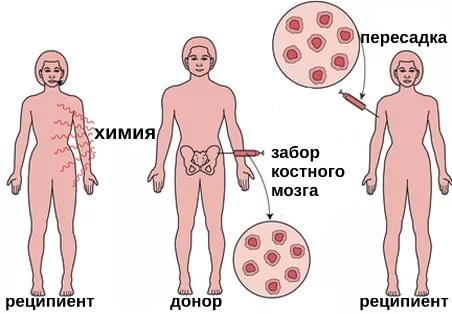Leukemia is a serious and dangerous disease of malignant origin. With it, the work of the hematopoietic system of the human body is disrupted.
Pathological processes negatively affect the functioning of all systems and internal organs as they progress. Characteristic symptoms appear. An oncologist is responsible for diagnostics and treatment in adults. His life depends on how quickly the patient goes to the hospital.
Record content:
- 1 What is Leukemia?
- 2 Causes
- 3 Forms, types, stages
- 4 The first signs in adults, children
- 5 The main symptoms
- 6 Distinctive symptoms by type of leukemia
- 7 Complications of hemoblastosis
- 8 Diagnostics
- 9 Signs of leukemia by blood test
-
10 Treatment of adults and children
- 10.1 Chemotherapy
- 10.2 Immunotherapy
- 10.3 Radiotherapy
- 10.4 Bone marrow transplantation
- 10.5 Follow-up treatment
- 11 Side Effects of Treatment
- 12 Folk remedies
- 13 Forecast
- 14 Video about leukemia
What is Leukemia?
Leukemia is a malignant disease that affects the hematopoietic system in the human body. The production of white blood cells is impaired. They protect the human body from infectious disease.
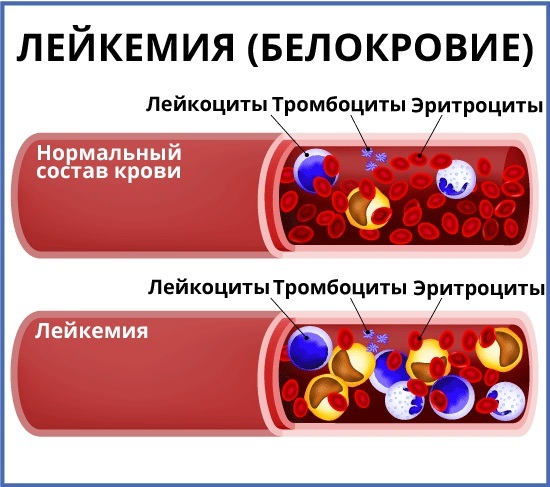 Pathological processes are accompanied by characteristic symptoms and require timely therapy in adults in order to avoid serious complications.
Pathological processes are accompanied by characteristic symptoms and require timely therapy in adults in order to avoid serious complications.
Causes
There are numerous factors that trigger the development of leukemia in a person:
| Name | Description |
| Chemotherapy | Treatment with special anticancer drugs or radiation therapy for another malignant neoplasm. |
| Congenital genetic disorders | Down syndrome increases the likelihood of developing leukemia. The same applies to other congenital diseases associated with genetic disorders in the body. |
| High radiation doses | We are talking about high ionizing radiation. |
| Chemical exposure | The risk category includes people who work in hazardous industries and come into contact with chemicals. |
| Bad habits | Cigarette abuse increases the risk of developing acute myeloid leukemia. |
| Heredity | If there were relatives in the family with such a diagnosis. The disease is inherited. |
Poor environmental conditions contribute to the development of pathological processes. The same goes for the wrong way of life.
Forms, types, stages
Considering the rate of development of malignant processes and the number of affected blood cells, in medicine, the following types of leukemia are distinguished:
| Name | Description |
| Sharp | The disease is characterized by the rapid division of malignant cells. In the area of the bone marrow, a tumor forms, which disrupts its functioning. Metastases and cancer cells spread throughout the body through the blood. Symptoms of acute leukemia appear early in development. The patient has little time, the risk of death is high. |
| Chronic | Cancer cells slowly spread throughout the human body, so there are no symptoms at an early stage of the disease. The patient has every chance of being cured. |
Leukemia develops in stages. Each form of the disease goes through certain stages.
Stages of acute leukemia:
| Name | Description |
| Initial | There are no pronounced clinical signs, so the person does not notice the changes. The disease at an early stage is more often detected during a blood test. |
| Deployed | Pathological processes are accompanied by clear and hematological clinical symptoms. |
| Terminal | Cytostatic therapy is ineffective. The functioning of the hematopoietic system is clearly disrupted. Necrotic ulcers appear. |
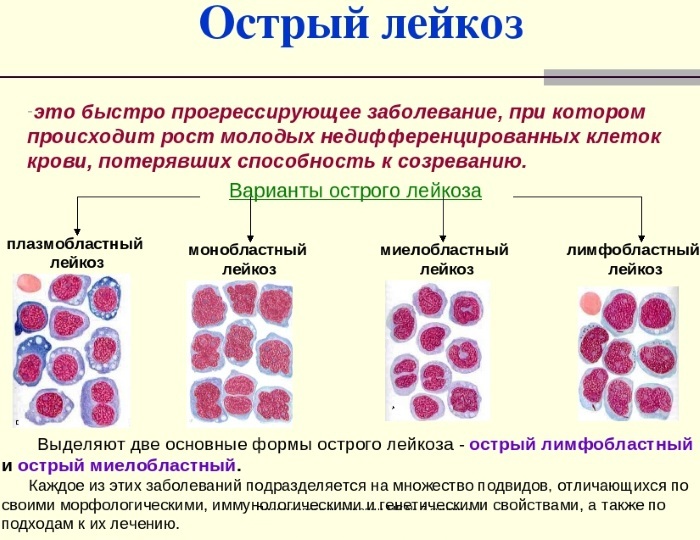
Stages of chronic leukemia:
| Name | Description |
| Chronic stage | Leukocytosis gradually increases, the likelihood of thrombocytosis increases. The disease at this stage does not manifest itself, rarely mild signs or anemic syndrome occur. |
| Acceleration stage | The blood picture changes, the sensitivity to the therapy that the patient previously underwent decreases. The characteristic symptoms are absent or mild. |
| Acute stage | There is a sharp decrease in the number of erythrocytes, platelets, granulocytes. Internal bleeding, ulcerative necrotic complications appear, and sepsis develops. |
The appearance of a large number of leukemic cells in organs and tissues entails serious complications. We are talking about anemia, dystrophic changes in the kidneys, infectious complications and hemorrhagic syndrome.
The first signs in adults, children
The clinical picture of leukemia in humans depends entirely on the degree of development of malignant processes.
The first symptoms are as follows:
| Name | Description |
| Pseudo-cold condition | Headache, fatigue and fatigue are attributed by many people to the common cold. |
| Anemia | A pathological condition characterized by a decrease in the level of hemoglobin. |
| Sweating | A symptom of leukemia, which often manifests itself with a high fever and at night. |
| Swollen lymph nodes | This applies mainly to those located in the armpit or on the neck. There is no pain syndrome with enlarged lymph nodes. |
| Enlargement of the liver and spleen | A symptom of malignant processes in which the patient complains of heaviness under the left or right ribs. |
The process of blood clotting is also disrupted. A person has bruises on the body, nosebleeds, red dots form under the skin.
The main symptoms
Symptoms of leukemia in adults also depend on the number of mutated cells, their distribution, and where they congregate.
The main symptoms of the disease are as follows:
| Name | Description |
| Bleeding | Leukemia provokes bleeding from the nose and skin. Women have profuse menstruation. |
| Bruising | A specific symptom of chronic leukemia that occurs suddenly, without mechanical damage.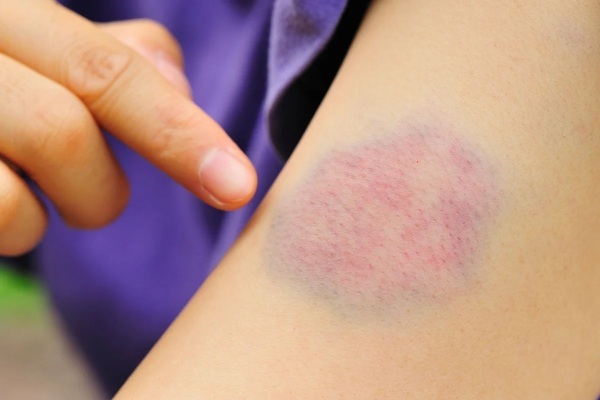
|
| Joint pain | Painful sensations occur in the chest and pelvic bones. |
| Chronic fever | A pathological condition that occurs against the background of an inflammatory process inside the body. The hypothalamus is activated, it is responsible for high body temperature. |
| Frequent infectious diseases | Against the background of reduced protection and weak immunity, frequent infectious pathologies develop, which are accompanied by nasal congestion, coughing. |
| Constant malaise | It occurs as a result of a decrease in the level of red blood cells. Accompanying signs are fatigue, weakness and depression. |
The clinical picture in acute leukemia can manifest itself immediately, pronounced in the early stages of the development of malignant processes. The chronic form of pathology for a long time proceeds without pronounced signs.
Distinctive symptoms by type of leukemia
Leukemia (symptoms in adults help a hematologist or oncologist make an accurate diagnosis) requires a thorough medical diagnosis.
| Name | Symptoms |
| Chronic myeloid leukemia |
|
| Chronic lymphoblastic leukemia |
|
| Acute lymphoblastic leukemia |
|
| Acute myeloid leukemia |
|
Typical symptoms will help the oncologist diagnose, assess the patient's condition and the degree of damage to the patient's body. It is important to have a complete medical examination and start treatment as early as possible to increase your chances of a successful prognosis.
Complications of hemoblastosis
The lack of timely diagnosis and treatment of leukemia has serious consequences. Complications worsen the patient's quality of life and, in some situations, lead to death.
Against the background of leukemia, the following consequences appear:
| Name | Description |
| Myeloma | The disease is characterized by the formation of a malignant tumor. It suppresses the work of the hematopoietic system, destroys bones, produces abnormal protein and affects internal organs. |
| Meningitis | A pathological condition against the background of which an inflammatory process develops that affects the lining of the brain. |
| Thrombocytopenia | A disease in which there is a significant decrease in platelet count. |
| Spleen infarction | Pathological processes provoke thrombosis, embolism or prolonged spasm of the organ's blood vessels. The spleen tissues die off. |
Complications of leukemia are also pneumonia, inflammation in the area of lymphatic tissue, cerebral hemorrhage, necrosis, and severe intoxication of the body.
Diagnostics
A medical examination allows the doctor to establish an accurate diagnosis and select the most effective treatment based on the results obtained.
With leukemia, patients are prescribed the following diagnostic measures:
| Name | Description |
| General and biochemical blood test | There is a decrease in the level of erythrocytes, platelets and hemoglobin. In some situations, blast cells are found in the patient's blood. |
| Puncture | The sampling of material for research is taken from the bone marrow, liver, spleen, skin infiltrates and enlarged lymph nodes.
|
| Computed tomography (CT) | Diagnostic methods that allow you to view the condition of the lymph nodes and lungs. |
| Chest x-ray | |
| Myelogram | The cellular composition of the bone marrow is examined. |
| Ultrasound examination of internal organs (ultrasound) | Diagnostics helps to identify large or small foci of malignant processes, as well as to identify specific kidney damage. |
| Electrocardiogram (ECG) | An examination method that allows you to assess the functioning of the heart muscle. |
Leukemia must be differentiated, since many pathologies are accompanied by similar symptoms. (autoimmune thrombocytopenic purpura, infectious mononucleosis, juvenile rheumatoid arthritis).
Signs of leukemia by blood test
Leukemia (symptoms in adults will help the oncologist choose an effective treatment, taking into account the person's condition) greatly affects the quality of the blood. Its analysis will allow the most accurate determination of malignant processes.
The results will show the following changes:
- the erythrocyte sedimentation rate (ESR) increases;
- the level of reticulocytes decreases;
- the number of leukocytes changes;
- the level of platelets decreases;
- the level of hemoglobin decreases;
- the concentration of mature cells drops sharply;
- there are no basophils, eosinophils.
In serum, which was obtained as a result of plasma clotting, the concentration of bilirubin increases. The same goes for uric acid, gamma globulins, urea.
Treatment of adults and children
Leukemia (symptoms in adults can help determine the degree and stage of a malignant disease) is diagnosed and treated by an oncologist or hematologist. It is important to strictly adhere to the treatment regimen selected by a specialist in order to avoid serious complications. The doctor takes into account the type and stage of the disease, the age of the patient, and accompanying clinical signs.
Chemotherapy
The main goal of treatment is remission of malignant processes.
Specific medications are prescribed:
| Name | Application | Contraindications |
| Asparaginase | The medicine is administered intravenously. The adult dosage is 200-300 IU / kg per day. The course of treatment is carried out for 30 days. |
|
| Vincristine | The drug is administered intravenously. Adults are prescribed at 0.4-1.4 mg / m2 Once a week. | The medicine is incompatible with furosimed. |
Treatment with chemicals is carried out in a hospital, so that doctors can respond promptly and quickly to complications.
Immunotherapy
Treatment allows you to improve the body's defenses and increase its resistance to malignant processes. The patient is given intravenous injections with specially selected drugs (Interferon), taking into account the person's condition and the individual characteristics of his body.
Of the side effects of immune therapy, the appearance of various rashes on the skin, the injection site swells. In some situations, the patient develops signs similar to those of the flu.
Radiotherapy
High dosages of X-rays are used to treat the patient. They destroy cancer cells, inhibit the growth of lymph nodes and spleen. 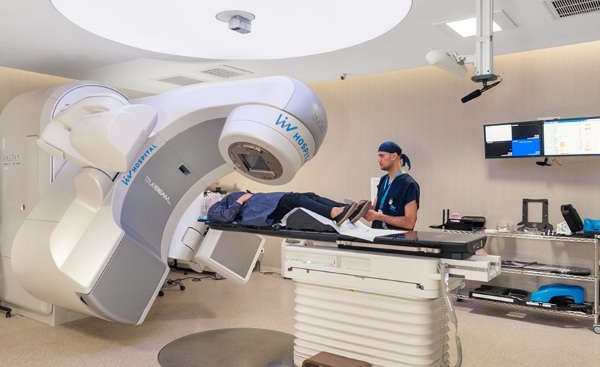 Radiation therapy is also prescribed before surgery.
Radiation therapy is also prescribed before surgery.
Bone marrow transplantation
Transplantation is indicated for patients if chemotherapy, radiotherapy have not yielded positive results. Stem cells help not only restore healthy cell production, but also strengthen the immune system.
Before surgery, chemotherapy or radiation therapy is given to destroy bone marrow cells. It is necessary to make room for new stem cells. Pretreatment also reduces immunity so that the transplanted cells can take root.
Follow-up treatment
Leukemia (symptoms in adults depend on the state of the immune system) requires follow-up therapy.
It is selected taking into account the existing symptoms of the patient:
| Drug group | Name | Application |
| Antibacterial drugs | Amikacin | The medicine is administered intravenously or intramuscularly. The adult dosage is 10 mg / kg, divided into 2-3 doses. The duration of treatment is 3-10 days.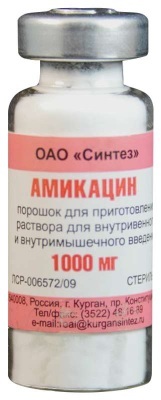
|
| Antifungal agents | Fluconazole | The medicine is taken orally at 200-400 mg once a day. The treatment lasts 7-30 days. |
| Antiviral medicines | Valacyclovir | Adults are prescribed 1-2 g 2-4 times a day, taking into account the person's condition. The course of treatment is 3-10 days. |
Additionally, detoxification therapy can be prescribed. It is impossible to completely get rid of leukemia. Doctors administer treatments to achieve sustained remission. The chronic form of the disease requires long-term maintenance therapy.
Side Effects of Treatment
The side reaction of the human body to the treatment of leukemia interferes with a normal life, discomfort appears.
| Name | Description |
| Consequences of radiation therapy |
|
| Negative effects after chemotherapy |
|
| Consequences of bone marrow transplant |
|
A low platelet count leads to bleeding in the mucous membranes. To eliminate such complications, the doctor additionally prescribes treatment.
Folk remedies
Recipes of healers and healers can be used for leukemia, if there are no serious contraindications. Unconventional methods will not help to completely get rid of malignant processes, but they will increase immunity and eliminate some of the symptoms of the disease.
Effective recipes for healers and healers:
| Name | Recipe | Application |
| Blueberry infusion | Pour blueberry leaves and berries (5-6 tablespoons) with hot water (1 liter) and leave for 1 hour. Strain and take for medicinal purposes. | The resulting blueberry broth is recommended to be drunk throughout the day. The course of treatment lasts 1-2 months, then you need to take a break and continue therapy. Every day, the broth should be prepared fresh. |
| Tincture of cinquefoil | Grind the root of the plant, pour 100 g of vodka (500 ml). The resulting mixture must be kept for 10 days in a dark place. Strain the finished tincture. | Tincture of cinquefoil is recommended to take 1 tsp. 3 times a day. |
| Flax seeds | Pour 250 g of seeds with hot water (3 L). Put on a steam bath and heat for 3 hours. Cool and strain the resulting broth. | The finished product is recommended to be taken throughout the day in small portions. The maximum adult dosage is 1 liter per day. |

Patients with leukemia are advised to eat 100-150 g of pumpkin seeds every day. In the fight against malignant processes, bee products help well. Patients are advised to consume 2 g of propolis 3 times every day.
Forecast
The prognosis of the disease depends on numerous factors. If leukemia is detected at an early stage of development, the patient has every chance to fully recover and continue normal life. The survival rate in this situation is 60%.
If the disease was diagnosed in the late stages of development, there is little chance of survival (10-12%). But medicine has recorded cases when, even in such a situation, patients survived and returned to their usual life.
Leukemia is a malignant blood disorder. Pathological processes interfere with the production of white blood cells. In adults and children, characteristic symptoms appear, with which it is necessary to go to the hospital, undergo an examination and begin treatment. Early diagnosis and therapy will help prevent complications and increase the chances of a better prognosis.
Video about leukemia
What is leukemia and what are its signs:

